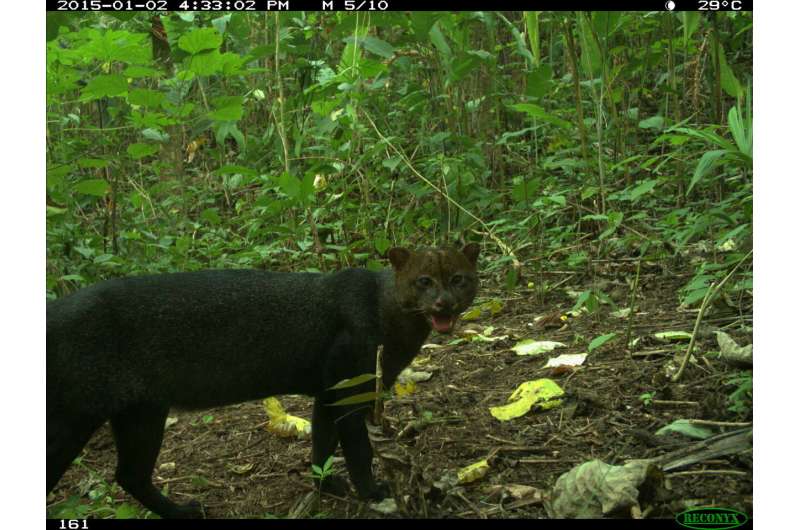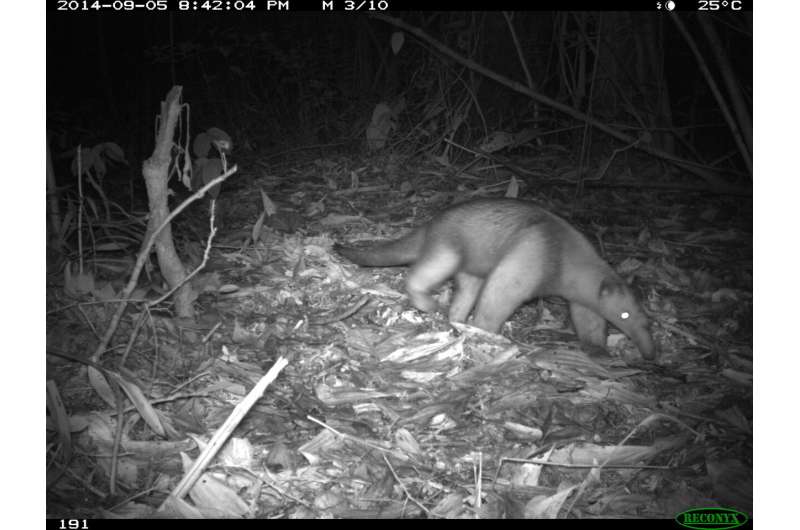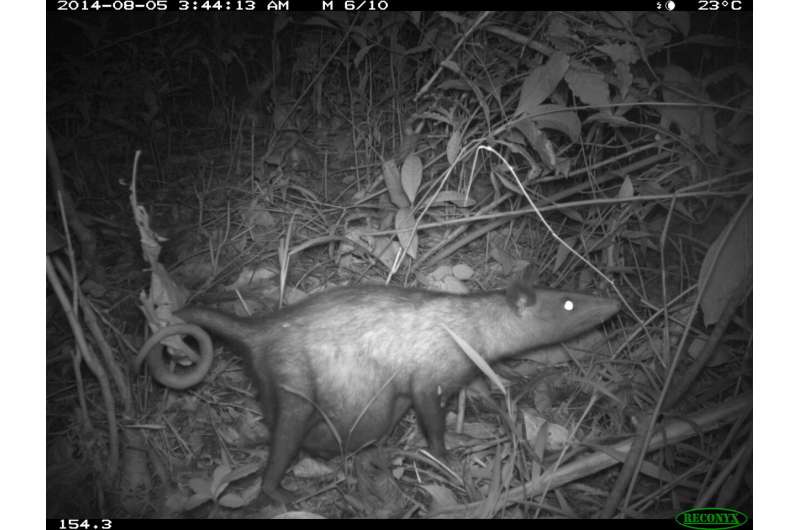This article has been reviewed according to Science X's editorial process and policies. Editors have highlighted the following attributes while ensuring the content's credibility:
fact-checked
peer-reviewed publication
trusted source
proofread
Timber plantations near urbanized areas support the movement of small and medium-sized terrestrial mammals

In the fight to mitigate climate change and deforestation in the tropics, timber plantations have emerged as a promising strategy for reforesting degraded land and connecting patches of natural forest. Often, these are species with commercial value for landowners but are not native to the region.
To evaluate how well non-native tree plantations support native wildlife in heavily human-impacted areas, researchers from the Smithsonian Tropical Research Institute (STRI), the Max Planck Institute of Animal Behavior (MPI-AB), Wageningen University & Research, and the University of California—Davis surveyed over 200 hectares of timber plantations in Central Panama for one year.
The paper is published in the journal Biotropica.
The team set camera traps—cameras with motion sensors— in small-scale timber plantations in Central Panama, the narrowest tract of land on the American continent. Centered around Nuevo San Juan, Colon, within the Panama Canal Watershed, the study area featured a diverse mosaic of timber plantation types, human settlements, agricultural fields, and road networks.
This region is critical for maintaining connectivity within the Mesoamerican Biological Corridor, facilitating movement for medium and large mammals like jaguars, pumas, coatis, tapirs, anteaters, and peccaries between Soberania National Park to the west and Chagres National Park to the east.
The researchers wanted to find out if terrestrial mammal species, including those of conservation concern, used the timber plantations in the area, either as habitats or as corridors to access natural forest fragments. They also wanted to know if the type of timber planted had any effect on whether the mammals used the plantations.

While working at STRI before his doctoral studies at MPI-AB, lead author Claudio Monteza started the camera trap study to find out more about biodiversity in unprotected forests.
"Most conservation efforts are focused on protected areas, so we wanted to know how wildlife was faring in the many unprotected forests of Panama," says the Panamanian scientist.
The team installed camera traps on five plantation types. Four were monocultures of the non-native timber trees teak, cedro, melina and acacia; one was a mix of native and non-native trees. Cameras on 79 sites collected data for a year, representing 3165 camera-trapping days.
Their analyses of the images found that 16 terrestrial mammal species, mostly small or medium in size and nocturnal, were using the plantations. Three of these species, the greater grison, jaguarundi and northern naked-tailed armadillo, are particularly elusive and sightings are rare even in natural forests.
However, no large mammals of conservation concern were detected. These results provide a rare glimpse into the state of wildlife on plantations and reveal their potential use as habitat or corridors for smaller mammals.
Although the findings could not reveal whether animals were using plantations as homes or merely passing through them, Monteza was still surprised by what he found.

"Clearly these plantations do not have the right resources to sustain large mammals," he says. "I remember vividly how during one-year of fieldwork, I only observed agoutis and coatis. So, it was heartening to find 16 native species of mammals using the land. Even if these areas are so impacted by human activity and far from protected forest."
However, not all plantations supported wildlife equally. Teak monocultures, which account for as much as 65% of the timber plantations in Panama, showed the lowest records of species compared to other plantation types.
In essence, while timber plantations provide some conservation benefits for smaller mammals by acting as corridors and refuges, their limitations in supporting large-bodied mammals of conservation concern highlight the importance of restoring natural habitats for comprehensive wildlife conservation efforts.
"Policy makers should realize that reforestation with monocultures of exotic species does not necessarily aid wildlife conservation," says co-author Patrick Jansen, from Wageningen University and STRI.
However, co-author Jefferson Hall from STRI believes the glass is still half full. Hall says, "Given that these plantations are in a sea of humanity, the fact that any small mammals were found here shows plantations can play a role as buffer zones for protected areas and corridors."
The authors caution that their study provides only a snapshot of the biodiversity present in Panama's timber plantations. Future studies should look at the diversity of plantations across the landscape to assess plantation conservation value writ large. For the team, these results are a first step in understanding the role of plantations in Panama's native fauna.
"These results are valuable for sustainable forestry practices," says Monteza. "It tells us what tree species strike the balance of supporting biodiversity as well as the livelihoods of private landowners. I hope decision-makers take into consideration small-scale private landholders for management plans."
More information: Claudio M. Monteza‐Moreno et al, Tropical timber plantations as habitat for ground‐dwelling mammals: A camera‐trapping assessment in Central Panama, Biotropica (2024). DOI: 10.1111/btp.13352
Journal information: Biotropica
Provided by Smithsonian Tropical Research Institute




















